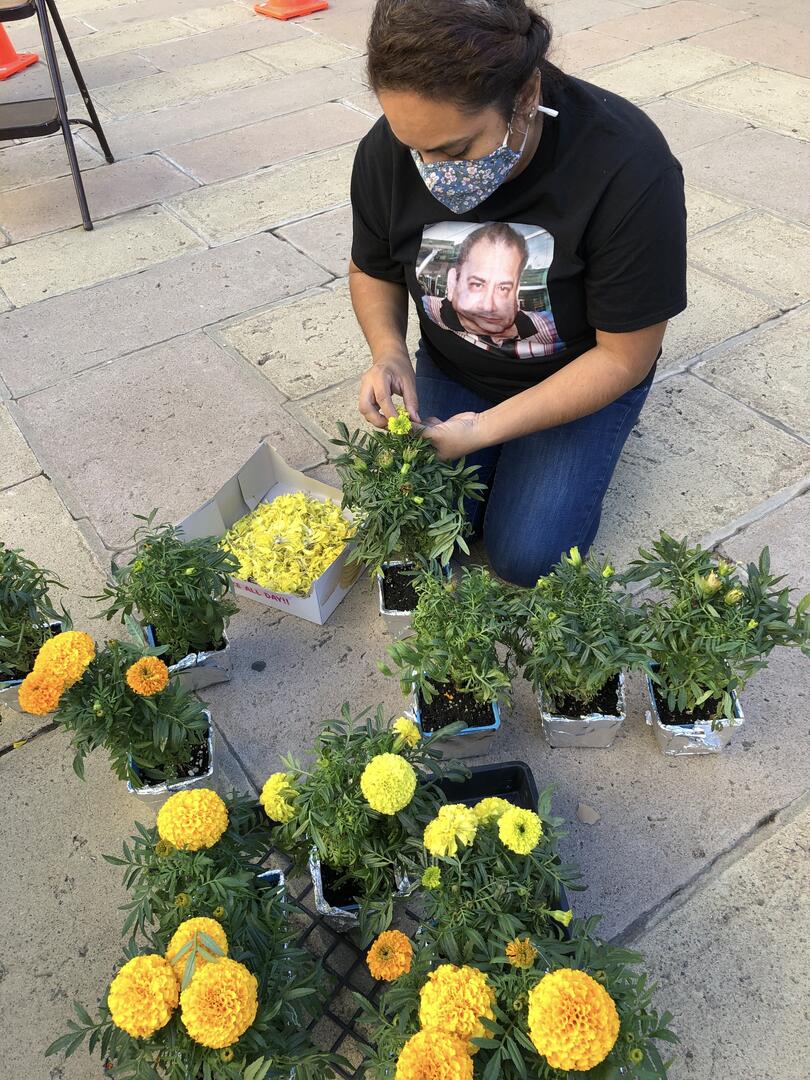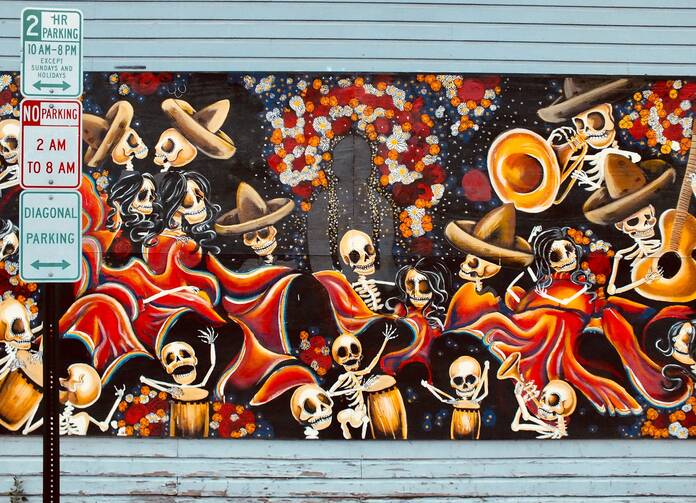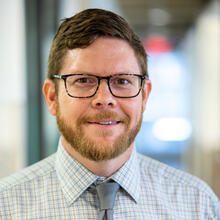Some people look at a skull and think of death. Others think of Hamlet. For many Mexicans, though, the skull is a sign of celebration. Death, afterall, is not the end.
Día de los Muertos, or the Day of the Dead, is celebrated each year on Nov. 2, the day the Catholic Church celebrates All Souls Day. Calaveras, depictions of human skulls, are a central image for the day.
“It’s a way of remembering the dead and that one day we, too, will pass to a different life,” Rosalia Meza, V.D.M.F., the senior director of the Office of Religious Education for the Archdiocese of Los Angeles, told me. “They’re made of sugar, decorated with flowers. They represent the dynamism of life and death.”
Sister Meza, who was born in Mexico, did not begin celebrating Día de los Muertos until she moved to the United States. She said her family was not very Catholic, but she learned the tradition while working with the immigrant community in this country.
Some people look at a skull and think of death. Others think of Hamlet. For many Mexicans, though, the skull is a sign of celebration. Death, afterall, is not the end.
“All of us, we lose someone that we love in life. We are confronted with death,” she said. “Día de los Muertos is a reflection on eternal life and the resurrection of Jesus Christ.”
The tradition has its origins in the indigenous communities of Latin America. “Indigenous people were and are highly spiritual,” Sister Meza said. “It’s an ancient indigenous tradition. They saw the connection with the larger universe. The dead are still a part of the community.”
The ofrendas, or altars, are another central aspect of the celebration. Often including a crucifix, the altars are decorated with pictures of deceased family members and friends. Cempasuchil, or marigold flowers, represent the glory of heaven, Sister Meza said. On the altar, families also place fruit, water, food and other items the deceased enjoyed in life. The candles represent the light of Christ, she said, and the bread is a reminder of the Eucharist.

Papel picado, designs cut out of colorful, thin paper, are another common decoration. “As the wind blows through these decorations, we are reminded of the fragility of life,” Sister Meza said.
“When someone dies that we loved so much, what stays with us is the love and the beautiful memories of the person,” she said. “You feel them close to you.”
In many Latin American countries, Día de los Muertos is a time to remember the anniversary of the passing of our loved ones. My family, for example, always remembers the days my Dominican grandfather and grandmother passed away. We go to Mass, think about them and share stories with each other. It is a sad day because we miss them so much.
Día de los Muertos, which is unique to Mexican culture, is not sad. It is a party. Death is not something sad or to be feared because the dead are remembered.
But Día de los Muertos, which is unique to Mexican culture, is not sad. It is a party. Death is not something sad or to be feared because the dead are remembered. “We remember them all together,” Sister Meza said. “It’s a community that we remember, and it’s not something we do alone or even as a family. We remember them as a community.”
This year, because of the Covid-19 pandemic, these celebrations will not be the same. Catholic Cemeteries Mortuaries of the Los Angeles archdiocese is trying to accommodate that by streaming a Nov. 1 prayer service, led by Archbishop José H. Gomez at Calvary Cemetery in East L.A.
[Don’t miss more stories like this one. Sign up for our newsletter.]
“These are our meaningful moments, All Souls and Día de los Muertos,” said Brian McMahon, the director of community outreach for Catholic Cemeteries. “These can be difficult enough days [because of the pandemic], but they can be more difficult when we cannot observe our traditions.”
While they will not host the annual Día de los Muertos celebration, Catholic cemeteries are able to safely accommodate visits to individual graves, Mr. McMahon said.
This year, the cemetery will display a number of public altars assembled by the community, including one dedicated to Kobe Bryant and his daughter, Gianna, one for immigrants and one for victims of Covid-19. Concepción Sánchez, whose father died of the virus in September, will take part in assembling the Covid-19 altar. She first started observing Día de los Muertos when her brother passed away six years ago.
This year, the cemetery will display a number of public altars assembled by the community, including one dedicated to victims of Covid-19.
“We couldn’t say goodbye to my dad because of Covid,” she said. “We were really close.”
Her father had been in and out of the hospital for the last two years dealing with illness. Those trips included a number of surgeries.
“We were there every time,” Ms. Sánchez said. “This time, since the first day he entered, he knew good or bad we weren’t going to be with him. We wanted to think everything was going to be O.K. The doctor told us, three of four days before he died, that [Covid] wasn’t in his system. But his immune system was so weak.”

The doctors said the virus triggered underlying immune issues. Twelve members of her family, whom she does not live with, have had Covid-19, she said. They will be participating in the livestreamed Mass.
“It’s a way of not forgetting about your loved ones,” Ms. Sánchez said. “Remembering that they were part of our family. For us to have closure and healing in our life.”
Eduardo and Ivonne López are also helping with the Covid-19 altar. Eduardo’s father died of Covid-19 this September. “In my case, the day will be very personal and will be the most meaningful yet because my father’s death is so recent,” he said. “Every day, I’m thinking about him, the sacrifices he made for us.”
“We are celebrating the soul, not death. It’s a day like Mother’s Day or Father’s Day. This is All Souls Day, so we have a special celebration for them.”
Eduardo is one of 13 brothers and sisters, and his thoughts have focused on how his father raised them. “He taught us our faith, how to work hard,” he said. “He was patient. He was a great human being. And that fills our hearts with pride. He was a great example to us.”
This year, Eduardo told me, Día de los Muertos is also a time for those who have not suffered because of the pandemic to be grateful for their health. It is a day for the living to be grateful for their lives.
Normally, the López family celebrates Día de los Muertos with many nearby relatives. But this year they will celebrate at home privately, Ivonne said. Her mother died in January, so Ivonne and Eduardo will both be commemorating their late parents on this Día de los Muertos.
“We are celebrating the soul, not death,” she said. “It’s a day like Mother’s Day or Father’s Day. This is All Souls Day, so we have a special celebration for them.”
More Stories from America:
– What the Day of the Dead can teach us about life
– Day of the Dead is not “Mexican Halloween”—it’s a day where death is reclaimed.
– I never had a reason to celebrate Day of the Dead. Now I remember my grandpa with Pan de Muerto.
– Disney tried to trademark ‘Day of the Dead.’ They make up for it with Pixar’s ‘Coco’









